#Cloud App Development
Explore tagged Tumblr posts
Text
0 notes
Text
The Future of Cloud App Development: Unlocking Business Value
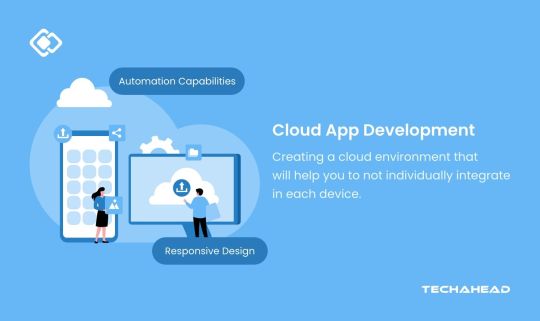
Cloud computing is rapidly transforming businesses. Many industry reports reveal that as business mobile applications grow, over 70% of digital workspaces face challenges with storage capacity and performance. The ideal solution to these issues is cloud app development, which provides unmatched scalability and flexibility.
Cloud app development simplifies data collection, enabling businesses to gather insights faster and more efficiently. It also enhances data security and streamlines management, making compliance and administration less burdensome. Cloud-powered development solutions empower businesses to create high-performance, productivity-focused applications that drive customer satisfaction and boost revenue.
Furthermore, cloud software solutions support low-code development, a time- and cost-efficient approach that minimizes extensive coding. This allows businesses to launch applications faster, optimizing resource usage and accelerating innovation cycles.
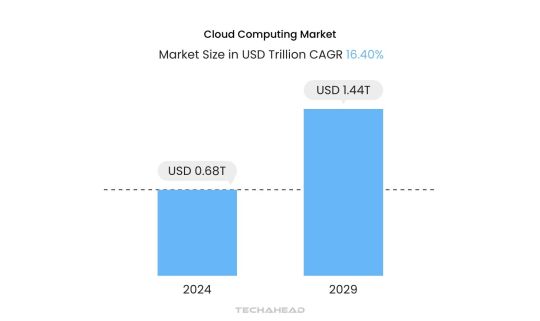
The cloud computing market is projected to grow substantially, with an estimated size of USD 0.68 trillion in 2024, anticipated to reach USD 1.44 trillion by 2029 at a CAGR of 16.40% (source: Mordor Intelligence). This robust growth highlights the rising demand for cloud solutions across industries. However, this rapid expansion in cloud applications prompts critical questions for businesses, especially around best practices in cloud app development.
In this guide, we’ll explore how to approach cloud app development effectively, the diverse cloud-based application solutions available, and how they drive value. You’ll gain insights into creating cloud applications that enhance operational efficiency, scalability, and customer engagement.
Let’s begin by examining the essentials that pave the way for efficient and future-ready cloud app development.
What is Cloud App Development?
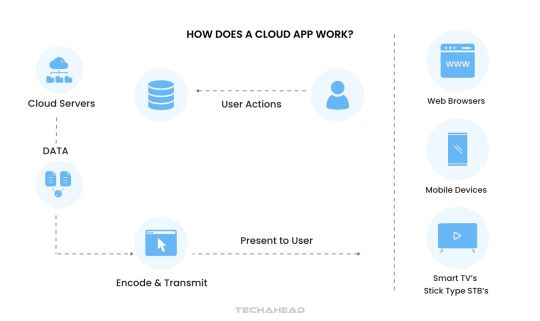
Cloud app development refers to creating applications within a cloud environment, bypassing the need for local servers. Unlike native applications, cloud-based apps rely extensively on cloud app development services, including data storage and processing, making them accessible through web browsers and other online platforms.
As enterprise development grows more reliant on cloud capabilities, they have leveraged its computational power to build groundbreaking solutions, transforming what’s possible in technology. Cloud services now empower companies to create a vast range of cloud applications that operate seamlessly on the web, often known as web apps.
These cloud apps are reshaping various business functions, taking over essential tasks like email, word processing, file storage, data collection, and even financial accounting. Through cloud app development, organizations are equipped with efficiency, streamline operations, and scale solutions like never before.
Types of Cloud App Development
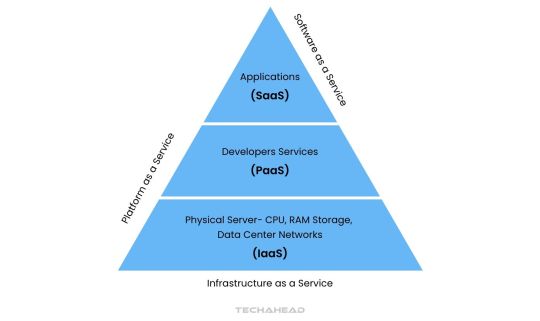
Software-as-a-Service (SaaS)
SaaS applications are hosted and maintained entirely by a cloud provider, making them accessible via the internet through web browsers. These applications relieve businesses from handling updates, server management, and software installations, as all maintenance is centrally managed by the provider. Users can seamlessly access features, integrate productivity tools, and share data across teams, which enhances operational efficiency.
Solutions like Google Workspace, Salesforce, and Slack exemplify SaaS by providing essential tools for collaboration, sales, and project management within a single, easily accessible platform.
Platform-as-a-Service (PaaS)
PaaS offers a managed environment for application development, which includes tools for building, testing, and deploying software while the cloud provider oversees infrastructure. By managing hardware and backend services, PaaS enables development teams to focus solely on cloud app development without the burden of configuring servers or databases. This platform accelerates time-to-market and streamlines scaling since the underlying resources are automatically adjusted as demand increases.
Examples like Microsoft Azure App Services and Google App Engine give developers robust frameworks and APIs, helping them build complex applications with minimal operational overhead.
Infrastructure-as-a-Service (IaaS)
IaaS delivers essential computing infrastructure such as virtual servers, storage, and networking resources. Unlike traditional on-premises infrastructure, IaaS allows businesses to pay for only the resources they use, which is ideal for scaling and managing large workloads flexibly. This model offers extensive control over the infrastructure, enabling IT teams to customize their environments and manage systems as needed.
Leading providers like AWS, Azure, and Google Cloud Platform provide services that allow companies to extend, scale, and secure their infrastructure easily, aligning with cloud app development needs for flexibility and resilience.
Function-as-a-Service (FaaS)
FaaS is part of serverless computing, allowing developers to deploy discrete code functions triggered by specific events, like user actions or system updates. With FaaS, there’s no need to manage or scale servers manually; the cloud provider handles it automatically based on demand. This model is ideal for applications requiring quick responses to high volumes of concurrent events, as it enhances cost efficiency and operational simplicity.
Popular FaaS services include AWS Lambda and Google Cloud Functions, which cater to cloud app development that prioritizes lightweight, highly scalable, and event-driven functionality.
Container-as-a-Service (CaaS)
CaaS leverages containers—lightweight, portable units of software that package application code along with its dependencies—for more efficient deployment and scaling across different environments. This model is highly beneficial for businesses adopting microservices architectures, as containers improve consistency in app deployment from development to production. CaaS platforms utilize orchestration tools, like Kubernetes, to automate the deployment, scaling, and management of containerized applications across multiple cloud or on-premises environments.
CaaS aligns with cloud app development demands for agility, allowing applications to scale seamlessly across hybrid or multi-cloud setups without compatibility issues.
Features of Every Cloud App Development Should Have
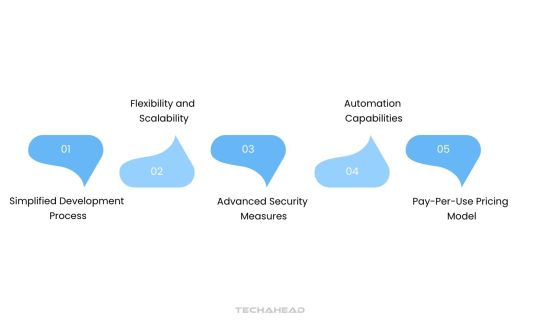
Simplified Development Process
An effective cloud app development platform should prioritize speed and simplicity. It should streamline architectural decisions, reducing complexity in creating and deploying applications across diverse technical environments. This simplicity allows hired developers to address challenges faster, minimizing errors and accelerating deployment. An efficient platform optimizes the overall development workflow, making it seamless to launch applications that meet high standards across various infrastructures.
Flexibility and Scalability
In cloud app development, flexibility is paramount. A robust platform should allow users to easily scale resources—adding or removing computing power, storage, and networking assets as demands fluctuate. Through automated scaling, these platforms adapt to dynamic workloads, preventing bottlenecks while ensuring optimal performance. During peak demand, a well-configured platform should instantly increase resources, and when demand lessens, it should scale down, maximizing cost-efficiency and resource allocation.
Advanced Security Measures
Security in cloud app development is a core feature, as cloud platforms employ top-tier security experts dedicated to threat management. These platforms adhere to stringent security protocols, often exceeding the protection provided by in-house teams. With compliance measures integrated, organizations can meet industry and governmental regulations effortlessly. Notably, 91% of companies report improved regulatory compliance post-cloud migration, emphasizing the cloud’s ability to safeguard data and ensure confidentiality.
You can also learn about the pillars of AI security and how it is protecting future technology.
Automation Capabilities
Automated processes are vital for managing complex, repetitive tasks in cloud app development. Advanced platforms support continuous integration and resource orchestration, which reduce operational burdens. Automation tools manage workload scaling, ensuring resources are available when needed without manual intervention. This allows IT teams to support growing demands efficiently while concentrating on strategic initiatives, enhancing overall operational efficiency.
Pay-Per-Use Pricing Model
A pay-per-use model enhances cost control within cloud app development, as users only pay for what they consume. This approach eliminates unnecessary expenses, allowing businesses to scale resources economically. Cloud providers track and report usage metrics, helping users monitor and optimize expenses. Some providers also offer a base level of free storage or computing power, making cloud resources even more accessible for startups and small businesses.
Steps to Take While Developing a Cloud App
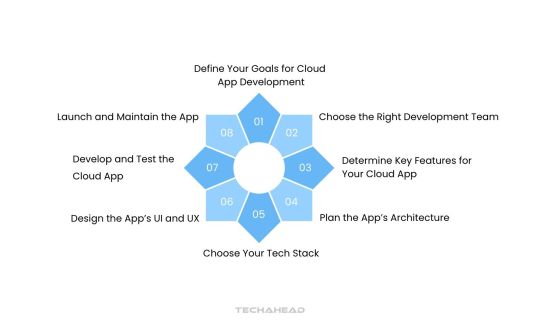
Creating a cloud app can involve web or mobile solutions, with the required technologies varying by solution type. Despite technical differences, the fundamental process in cloud app development follows similar phases to build a robust, user-centered application.
Step 1: Define Your Goals for Cloud App Development
Establishing clear objectives is crucial before development begins. Align all stakeholders on the project’s vision and goals during the discovery phase, helping the team understand the core business needs.
Reasons to consider cloud app development include:
Workflow automation: Streamlining repetitive tasks saves time and resources
Centralized data storage: Access and manage data easily within a single, organized environment.
Enhanced team collaboration: Improve internal communication and ensure seamless data exchanges.
Advanced reporting and analytics: Gain valuable insights to drive data-based decisions.
The discovery phase also allows developers to identify project scope, complexities, potential challenges, and costs. If a swift market entry is critical, a Minimum Viable Product (MVP) may be the best first step.
Step 2: Choose the Right Development Team
Cloud app development requires specialized skills, so selecting the right development team is essential. You can opt for freelancers, in-house talent, or outsource to a software development company.
Choosing a reliable cloud app development partner ensures ongoing support as the app evolves. Here are some questions to assess potential developers:
Can you share similar cloud app projects you have handled?
What platforms and technologies are you skilled in?
How do you prioritize security and scalability in development?
How do you approach cost management for cloud resources?
Can you ensure effective collaboration throughout the project?
A reliable development partner can adapt the app as technology advances and business needs grow.
Step 3: Determine Key Features for Your Cloud App
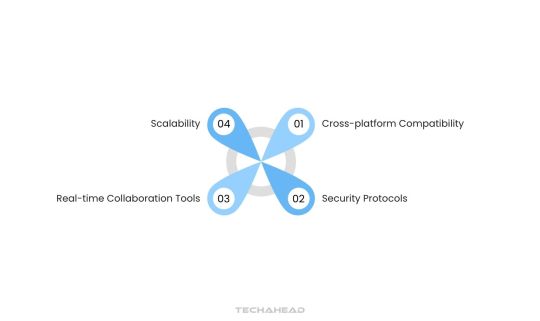
Identify core features that create a user-friendly experience in cloud applications. Essential features include:
Cross-platform compatibility: Allow users to access the app on their preferred devices.
Security protocols: Implement logins and access controls to protect user data.
Real-time collaboration tools: Enable users to work together through features like chat, live comments, and shared documents.
Scalability: Ensure the app can handle increasing users or workload.
Incorporating these features enhances user satisfaction and engagement, setting your app up for success.
Step 4: Plan the App’s Architecture
Your app’s architecture is the backbone of cloud app development, influencing scalability, security, and cost efficiency. Choose an architecture that aligns with your project’s requirements.
Key options include:
Monolithic architecture: A single, interconnected application; easy to develop but challenging to scale.
Microservices architecture: Divides the app into independent services; highly scalable but may face performance trade-offs.
Serverless architecture: Uses event-triggered functions in a serverless environment, ideal for low-maintenance, scalable solutions.
Hybrid architecture: Combines on-premises and cloud resources for high flexibility but may involve integration complexities.
Select an architecture that best aligns with your cloud app development goals. You can also look into this guide on Serverless Vs. Microservices architecture.
Step 5: Choose Your Tech Stack
The technology stack determines how quickly, securely, and effectively the app functions. Different projects require different combinations of programming languages (e.g., Java, Python, Node.js), databases (e.g., MongoDB, Firebase), frameworks (e.g., React, Angular), and containers (e.g., Docker, Kubernetes).
For instance, a Python-based stack offers scalability and maintenance ease, while Ruby on Rails works well for prototyping and collaboration. Choose the right tech stack that aligns with your app’s performance and integration needs.
Step 6: Design the App’s User Interface (UI) and User Experience (UX)
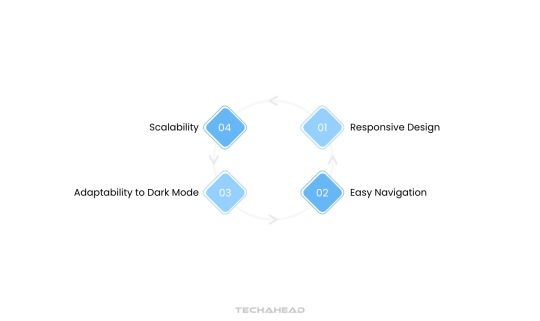
Effective UI/UX design is vital in cloud app development to create intuitive and visually appealing apps. Consider these elements:
Responsive design: Ensure seamless functionality across platforms and screen sizes.
Easy navigation: Users should quickly find what they need with minimal guidance.
Adaptability to dark mode: Offer both light and dark modes to reduce eye strain.
Scalability: Design a UI that accommodates future growth and additional features.
A responsive, intuitive, and adaptable UI makes the app user-friendly and future-proof. You can learn more about the Mobile UI designs as well.
Step 7: Develop and Test the Cloud App
Cloud app development typically uses Agile or DevOps methodologies, depending on project needs and team preferences.
Agile development emphasizes short, iterative development cycles, with regular testing and feedback after each sprint. Agile promotes flexibility, allowing the team to adapt to evolving requirements.
DevOps fosters collaboration across development and operations, with a focus on Continuous Integration/Continuous Delivery (CI/CD) and automation for efficient testing and deployment.
Both approaches streamline development, but the choice depends on team readiness and project goals.
Step 8: Launch and Maintain the App
Successful cloud app development doesn’t end with deployment. Continuous maintenance keeps your app relevant, responsive, and secure. Essential areas include:
Security updates: Regular patches to safeguard user data.
Performance optimization: Keep the app fast and responsive as usage grows.
Scalability adjustments: Ensure the app scales efficiently as demand fluctuates.
Technology updates: Adapt the stack to new versions or libraries.
Ongoing maintenance ensures a secure, scalable, and high-performing cloud app that keeps pace with technological advancements and user expectations.
Benefits of Cloud App Development
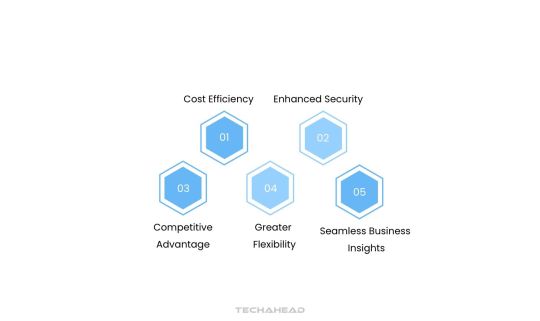
Cost Efficiency
Cloud app development significantly reduces costs by eliminating the need for on-premise infrastructure. With cloud-based applications, businesses only pay for the services they use, making it approximately 40% more affordable for small companies. This pay-as-you-go model means businesses can adjust monthly expenses based on usage, resulting in ongoing cost control.
Unlike traditional hardware, which requires significant upfront investment, cloud solutions offer flexible pricing that can scale with business growth. Additionally, many providers offer cost-saving options, like discounts on long-term contracts for larger enterprises.
You can learn more about the cost of app development.
Enhanced Security
Data security remains a huge priority when it comes to cloud app development. While integrating them, they tend to provide robust protection that safeguards sensitive information. Top cloud-based service providers employ advanced encryption techniques. It all helps in making it harder to get data accessibility for unauthorized users.
Even if there’s an intrusion attempt, encryption ensures data remains protected. Cloud hosting also includes 24/7 monitoring by specialized security teams, often surpassing the reliability of in-house systems. Research shows that 94% of businesses have reported enhanced data security after moving to cloud-based applications, demonstrating its effectiveness in managing data integrity and safety.
Competitive Advantage
Leveraging cloud app development gives companies a significant competitive edge. Cloud services handle infrastructure management, freeing up IT teams to focus on innovation and growth-centric initiatives. With a faster deployment cycle and access to the latest cloud technologies, cloud-enabled companies stay ahead in a rapidly evolving market.
Studies indicate that 77% of organizations find cloud technology helps maintain a competitive advantage. Cloud providers regularly update their offerings, allowing businesses to utilize state-of-the-art tools without needing continual hardware upgrades.
Greater Flexibility
Cloud app development introduces flexibility that in-house servers can’t match, especially in scaling resources. Teams no longer need to worry about storage or bandwidth limitations since cloud infrastructure can easily expand based on demand. This adaptability enables businesses to swiftly respond to changing market needs and to adjust resources during peak times. By outsourcing app development to cloud providers, in-house teams can focus on creating impactful solutions that directly support business objectives, fostering a more agile methodology, and resilient organization.
You can learn more about Offshore Vs. Onshore.
Seamless Business Insights
Current data-driven environment, the insights derived from cloud app development are invaluable. Cloud storage solutions offer powerful analytics tools that allow businesses to process and analyze data effortlessly. With these tools, businesses can gain actionable insights, create detailed reports, and use real-time data to enhance decision-making.
Conclusion
Cloud computing is transformative, future-ready technology that drives business scalability, efficiency, and sustainable growth. Leveraging cloud app development, companies startups or even established enterprises can significantly enhance performance, streamline operations, and cut down on overhead expenses.
Investing in cloud app development services is a strategic step for any business aiming to launch a resilient, next-gen mobile application. Given the technical expertise required for implementing cloud infrastructure in mobile applications, it’s advisable to engage skilled app developers with experience in startup solutions.
Source URL: https://www.techaheadcorp.com/blog/cloud-app-development-reaching-the-value-infection-point/
0 notes
Text

Key Facts About Cloud Application Development
Cloud application development has revolutionized how businesses design, deploy, and manage software solutions. By leveraging cloud computing, organizations can access scalable, cost-effective, and flexible resources that drive innovation and efficiency. The shift to cloud-based applications offers numerous benefits, including enhanced accessibility, automatic updates, and robust security. As companies increasingly adopt cloud technologies, understanding these key aspects becomes essential for maximizing the potential of cloud application development and staying competitive in the digital landscape.
Scalability and Elasticity: Cloud applications can automatically adjust resources based on demand. This means they can handle spikes in traffic by scaling up resources and scaling down during quieter periods, ensuring efficient performance and cost management.
Cost Efficiency: Cloud development reduces the need for significant upfront capital investment in hardware. Instead, companies pay for the resources they use, which can lead to lower overall costs and a more predictable budget.
Accessibility: Cloud applications are accessible from anywhere with an internet connection, enabling remote work and global collaboration. This flexibility allows users to interact with applications using various devices and locations.
Automatic Updates: Cloud providers handle software updates and maintenance, ensuring applications are always running the latest features and security patches without user intervention. This reduces the burden on IT teams and minimizes security risks.
Disaster Recovery: Cloud platforms offer built-in backup and disaster recovery solutions. Data and applications are automatically backed up and can be quickly restored in case of data loss or system failures, ensuring business continuity.
Flexibility and Customization: Cloud services provide a wide range of tools and resources, allowing developers to build and customize applications to meet specific business needs. This includes access to databases, analytics, machine learning, and more.
Enhanced Security: Leading cloud providers invest heavily in security measures, including encryption, identity management, and regular security assessments. They also comply with industry standards and regulations, ensuring data protection and privacy.
Global Performance: Cloud providers have a network of data centres worldwide. This global infrastructure helps improve application performance by reducing latency and load times, delivering a better user experience.
Seamless Integration: Cloud applications can easily integrate with other cloud services and on-premises systems. This allows for smooth data flow and interoperability between different applications and platforms.
Innovation and Advanced Technologies: Cloud platforms offer access to cutting-edge technologies such as artificial intelligence, big data analytics, and the Internet of Things (IoT). This enables businesses to innovate and develop sophisticated applications with advanced capabilities.
These facts highlight the significant advantages and capabilities of cloud application development, emphasizing why it is a popular choice for modern software solutions.
#cloud computing#cloud application development#cloud app development#application development#android app development#ios app development#web app development#software development#custom app development#game development#cloud devops services
0 notes
Text
Key Benefits of Using Cloud App Development Services for Startups

Discover how #cloudappdevelopmentservices provide startups with cost efficiency, scalability, enhanced security, and access to advanced technologies for growth.
#cloud devops integration#cloud app development#cloud solutions#cloud technology#cloud devops services#technology#Cloudservicesforstartups
0 notes
Text
Best Cloud App Development Services in 2024
In 2024, the best cloud app development services are characterized by their ability to offer scalable, cost-efficient solutions with ease of collaboration. These services are part of a diverse ecosystem designed to streamline the creation, testing, and deployment of cloud-based applications, ensuring developers have the tools they need for modern software development.
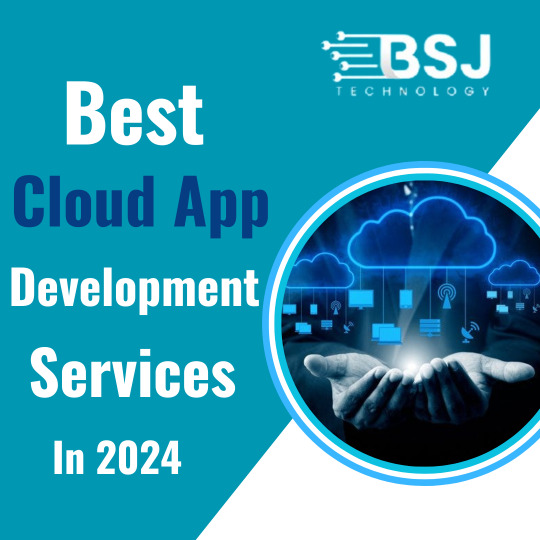
#bsjtechnology#business#technology#mobile application#smart phones#marketing#web development#services#software#cloud app development#cloud services
0 notes
Text
At Closeloop, we specialize in developing and securing cloud-based applications. Our team of experts combines the latest technologies, industry best practices, and comprehensive testing to ensure your applications are protected from potential threats. Whether you need to create new applications or enhance the security of existing ones, we have the knowledge and tools to minimize risks and safeguard your data through Cloud application development solutions.
#cloud solutions#cloud application development#cloud app development#cloud application development services
1 note
·
View note
Text
0 notes
Text
Cloud App Development: Why Not Implementing Autoscaling Is a Big Mistake
In the aspect of cloud-based application development, staying competitive requires more than just deploying your application to the cloud. It demands a thorough understanding of how to harness the full potential of cloud resources while optimizing costs and performance. One key aspect often overlooked is autoscaling.

In this blog, we'll explore why not implementing autoscaling can be a significant mistake in cloud-based application development and how cloud consulting and custom cloud application development can help you avoid this pitfall.
The Importance of Scalability in Cloud-Based Application Development
Scalability is a fundamental requirement for modern cloud-based applications. It's the ability to handle varying workloads efficiently without manual intervention, ensuring a seamless user experience during both normal and peak usage periods. Traditionally, scaling involved provisioning more resources upfront to accommodate expected loads, resulting in idle resources during periods of low activity.
The Downside of Manual Scaling
Before diving into the specifics of autoscaling, let's discuss the drawbacks of manual scaling, which was common in the pre-cloud era and is still practiced by some developers in the cloud:
Inefficiency: Manual scaling often leads to underutilized resources during low-traffic periods and potential resource shortages during unexpected spikes.
Increased Costs: Over-provisioning to handle peak loads can significantly increase cloud infrastructure costs, eroding potential cost savings.
Operational Complexity: Continuously monitoring and adjusting resources manually can be time-consuming and error-prone.
Limited Responsiveness: Manual scaling struggles to react quickly to sudden traffic surges, potentially resulting in service interruptions or poor performance.
Autoscaling: A Solution Tailored for the Cloud
Autoscaling addresses these issues by automatically adjusting the number of compute resources based on real-time traffic and application demands. It optimizes resource allocation, ensuring that you only pay for what you use while maintaining consistent performance. Autoscaling in cloud-based application development offers several key advantages:

Cost Optimization: Autoscaling ensures you're not paying for idle resources, resulting in significant cost savings over manual scaling.
Improved Performance: The ability to add or remove resources dynamically ensures that your application can handle varying loads while maintaining optimal performance.
Enhanced Reliability: Autoscaling can help maintain service availability by quickly responding to increased demand and mitigating potential resource shortages.
Simplified Operations: With autoscaling, much of the resource management is automated, reducing the operational burden on your development and operations teams.
The Role of Cloud Consulting
Implementing autoscaling effectively requires a deep understanding of cloud services, application architecture, and performance monitoring. This is where cloud consulting comes into play. Cloud consultants are experts in cloud technologies who can assess your specific needs and design a customized autoscaling strategy for your cloud-based application.

Custom Cloud Application Development with Autoscaling
Integrating autoscaling should be a fundamental part of the development process when building custom cloud-based applications. Cloud application developers should consider the following steps:
Design for Scalability: Develop your application with scalability in mind, making it easier to adapt to changing workloads.
Select the Right Metrics: Choose the right performance metrics to trigger autoscaling actions based on your application's requirements.
Define Scaling Policies: Establish clear rules for scaling actions, such as adding or removing instances based on traffic thresholds.
Continuous Monitoring: Implement robust monitoring and alerting systems to track application performance and trigger autoscaling as needed.
Regular Testing: Test your autoscaling configurations under various traffic conditions to ensure they respond effectively.
Optimize Costs: Implement cost optimization strategies alongside autoscaling to ensure you get the most value from your cloud resources.
Conclusion
In the world of cloud-based application development, implementing autoscaling is a mistake that can lead to efficient resource utilization, increased costs, and operational challenges. To avoid this pitfall, consider leveraging the expertise of cloud consulting services and incorporating autoscaling as a core component of your custom cloud application development strategy. By doing so, you'll ensure that your applications can adapt and thrive in the dynamic landscape of the cloud.
0 notes
Text
Our Cloud App Development services help you ensure a seamless transition of business applications and data to leading cloud platforms such as Microsoft Azure, AWS, GCP, VMWare, IBM, and other enterprise solutions.
#zymr#cloud app development services#cloud computing in healthcare#cloud app development#qa automation#qa testing
0 notes
Text

40 notes
·
View notes
Text
Empower Your Digital Presence with Cutting-Edge Frameworks
In today’s fast-evolving digital landscape, staying ahead requires more than just a functional website or application—it demands innovation and efficiency. At Atcuality, we specialize in Website and Application Framework Upgrade solutions tailored to your business goals. Whether you're looking to optimize performance, enhance user experience, or integrate the latest technologies, our team ensures seamless upgrades that align with industry standards. Transitioning to advanced frameworks not only improves loading speeds and scalability but also strengthens your cybersecurity measures. With Atcuality, you gain access to bespoke services that future-proof your digital assets. Let us elevate your online platforms to a new realm of excellence.
#ai applications#artificial intelligence#ai services#website development#website developer near me#website developers#website developer in india#web development#web design#application development#app development#app developers#digital marketing#seo services#seo#emailmarketing#search engine marketing#search engine optimization#digital consulting#virtual reality#vr games#vr development#augmented reality#augmented and virtual reality market#cash collection application#task management#blockchain#metaverse#cloud computing#information technology
8 notes
·
View notes
Text
Abathur

At Abathur, we believe technology should empower, not complicate.
Our mission is to provide seamless, scalable, and secure solutions for businesses of all sizes. With a team of experts specializing in various tech domains, we ensure our clients stay ahead in an ever-evolving digital landscape.
Why Choose Us? Expert-Led Innovation – Our team is built on experience and expertise. Security First Approach – Cybersecurity is embedded in all our solutions. Scalable & Future-Proof – We design solutions that grow with you. Client-Centric Focus – Your success is our priority.
#Software Development#Web Development#Mobile App Development#API Integration#Artificial Intelligence#Machine Learning#Predictive Analytics#AI Automation#NLP#Data Analytics#Business Intelligence#Big Data#Cybersecurity#Risk Management#Penetration Testing#Cloud Security#Network Security#Compliance#Networking#IT Support#Cloud Management#AWS#Azure#DevOps#Server Management#Digital Marketing#SEO#Social Media Marketing#Paid Ads#Content Marketing
2 notes
·
View notes
Text
Trusted outsource software development teams - SSTech System

Outsource software development is the practice of relinquishing software-related duties to outside singularities or organizations. Outsourcing is used by firms to acquire software services and products from outside firms that do not have direct employees or employees under contract to the business entity that is outsourcing.
Infect, the outsourcing market worldwide is projected to grow by 8.28% (2025-2029) resulting in a market volume of US$812.70bn in 2029. This model is highly versatile and suits businesses of all sizes.
Start-ups often use outsourcing to develop MVPs quickly, while established companies might seek custom software development services or AI outsourcing services to address complex challenges. Outsourcing can include working with offshore development teams, global software development partners, or local experts like Australian software development experts for specific projects.
The benefits of outsourcing software development
Outsourcing has become a cornerstone for modern businesses due to its numerous advantages. Here’s a closer look at the key benefits:
1. Cost efficiency
Perhaps the biggest incentive for sourcing solutions from outsourcing service providers is the cost cutting factor. For instance, offshore software development in India provides expertise services at comparatively lower cost than that of in-house developed services in Western countries. This efficiency enable the enactments of cost savings in some other strategic sectors of the organization.
2. Access to global talent
Outsourcing can help to discover the wealth of new talents as well as the skills of professionals from other countries. No matter Whether it’s AI and machine learning integration, web application development in Australia, or outsourced healthcare software development, businesses can find experts in virtually any domain.
3. Scalability and flexibility
Outsourcing offers flexibility that is unparalleled in many organizations today. This is because; firms are able to expand and contract particular teams depending on the specific demand in projects. For example, outsourced IT solutions help business organizations prepare for different conditions while not having to employ permanent workers.
4. Faster time-to-market
With reliable software development teams in Australia or offshore development teams in India, businesses can speed up their project timelines. This helps innovations to make it through to the market early enough, which is useful for companies.
5. Focus on core activities
By delegating tasks like software maintenance and support or cloud software development in Australia to outsourcing partners, businesses can focus on their core competencies and strategic goals.
6. Reduced risk
In-house staff and trained outsourcing partners come with best practices, methods and procedures which when implemented reduce the chances of project hitch. Working with the top-rated IT outsourcing companies in Australia gives you confidence that your project is in safe hands.
Choosing the right outsourced software development partner

In the period from 2023 to 2027, the revenue of software outsourcing is forecasted to thrive at a CAGR of 7.54%. So, outsourcing partner selection is one of the most vital components since it determines the success of a given venture. Here are essential factors to consider:
1. Technical expertise
Check the partner’s competency and his knowledge of the field. For instance, SSTech System Outsourcing offers comprehensive solutions, from AI development services in India to mobile app development outsourcing in Australia.
2. Proven track record
Look for partners with a strong portfolio and positive client testimonials. A proven track record in delivering custom software development services or managing outsourcing software development contracts is a good indicator of reliability.
3. Effective communication
Effective and open communication is extremely important if the project is to be successful. Work with people who give frequent reports and employ efficient media to overcome the differences in time areas.
4. Cultural compatibility
There has to be a cultural match or at least appreciation for each other’s customs for there to be harmony in the working relationship. As such, staffed with proficient Australia software development experts or offshore development teams, whose experience is to work on global markets can coordinate and blend well with your work culture.
5. Security and compliance
You have to make sure that your partner complies with the standards and the policies that are in the industry. This is especially substantial for all information-sensitive projects such as outsourced healthcare software development or cloud software development in Australia.
6. Scalable infrastructure
Choose a partner capable of scaling their resources and infrastructure to meet your project’s evolving needs. This is crucial for long-term collaborations, especially with global software development partners.
AI-powered tools for outsourced development teams
According to a report from the US Bureau of Labor Statistics, software development ranks among the most sought-after professions. Hence, AI is at the forefront of reshaping the outsourcing industry. Therefore, the implementation of artificial intelligence will add value to business processes, make workflow easier, and boost the results of projects. Here are some examples:
1. Automated code reviews
Tools like DeepCode and SonarQube assist outsourced teams in detecting whether errors reside in the code line or not, and whether code needs to be enriched or not. This is particularly accurate concerning AI outsourcing and in-house development industries.
2. Predictive analytics
Automated analytics tools can predict such things as the time it will take to complete the project, how much money it will cost, and what risks are possible in a software development outsourcing scenario.
3. Smart project management
Tools and platforms such as Jira and Monday.com, when empowered with AI, allow the coordination of tasks and the tracking of progress and resource allocation.
4. AI collaboration tools
Communication and collaboration with internal members and offshore software development Australia partners get facilitated through applications that include, Slack, Microsoft Teams, and zoom with integrated AI functions.
5. Natural Language Processing (NLP)
AI-powered chatbots and virtual assistants simplify communication and issue resolution, making them valuable for managing outsourced IT solutions.
Best practices for managing outsourced development teams
Outsourced teams should be mandated and coordinated following a number of recommendations to ensure the efficiency of the entirety of the outsourcing process.
Here are the best practices to ensure your project’s success:
1. Set clear objectives
Make it clear to your project team, stakeholders, and other relevant parties what the parameters of the project are, what it is that you expect out of it, and what you expect to get from it in return. This fostaines consistency between your team and the outsourcing partner to increase efficiency in service delivery.
2. Choose the right tools
Use project tracking and collaboration software approaches to track and evaluate progress and meet regular informality and collaboration targets.
3. Foster a collaborative environment
It is worthy of note that constant communication is key to ensuring that your outsourcing team is on the same page with you. Fresh produce and feedback mechanisms need to be provided in order for there to be trust as is needed in project management.
4. Draft comprehensive contracts
There should be a comprehensive outsourcing software development contract. It should address issues to do with confidentiality, ownership of ideas and concepts, plea structure and mode of handling disputes.
5. Focus on long-term relationships
Building a long-term partnership with trusted providers like SSTech System Solutions can lead to consistent quality and better project outcomes.
Conclusion
To keep up with technology, outsourcing software development offers businesses solutions and support that can enable the creation of complex solutions out of mere ideas. Outsourcing has the benefits of minute overhead cost and is also a rich source of globally talented employees, and it offers the advantage of early time to market. Whether you’re looking for mobile app development outsourcing in Australia or seeking offshore software development in India or opting for AI outsourcing services, the potential is huge.
Such companies can only benefit from opting for reliable outsourcing companies such as SSTech System Outsourcing and embracing industry best practices to promote the success of business project implementations while enhancing market relevance. As technologies like AI and cloud computing are still changing the face of the outsourcing market, software development outsourcing will still be important for any company that wants to survive in a digital world.
Take the first step today—partner with global software development partners and unlock the full potential of your ideas with the power of outsourcing.
#SSTech System Outsourcing#SSTech System Solutions#AI outsourcing services#cloud computing#offshore software development#Outsource software development#AI outsourcing#web application development in Australia#custom software development services#mobile app development#outsourced IT solutions#cloud software development#IT Support & Maintenance Services
4 notes
·
View notes
Text
Trusted Cloud Development Services in Europe
Europe's trusted cloud development services in are renowned for their robust security, scalability, and innovative solutions. These services cater to a diverse range of industries, offering tailored cloud infrastructure that ensures operational efficiency and strategic growth. Embrace the future with Europe's reliable cloud experts.

#bsjtechnology#business#technology#cloud app#cloud software#cloud app development#web development#web application
0 notes
Text
WordPress Security Services Tailored to Your Business Needs
Atcuality understands that every WordPress website has unique security needs. Our specialized WordPress security services provide customized solutions to safeguard your website from malicious attacks, unauthorized access, and technical vulnerabilities. Whether you own a blog, corporate website, or online store, our comprehensive approach includes malware scanning, vulnerability patching, firewall implementation, and site backups. Atcuality’s team of security professionals works tirelessly to monitor and eliminate threats before they can impact your business. With advanced tools and strategies like SSL encryption and uptime monitoring, we ensure your website operates securely while maintaining peak performance. Cyber threats evolve daily, but with Atcuality, you can stay one step ahead. Don’t let your website become a target—secure your site and maintain customer trust with our proven WordPress security solutions.
#seo marketing#seo services#artificial intelligence#digital marketing#iot applications#seo company#seo agency#amazon web services#azure cloud services#ai powered application#ai applications#ai app development#virtual reality#vr development#vr games#wordpress#web developers#web development#web design#web developing company#website developer near me#wordpress development#web hosting#website#augmented and virtual reality market#augmented human c4 621#augmented intelligence#augmented reality#iot#iotsolutions
4 notes
·
View notes